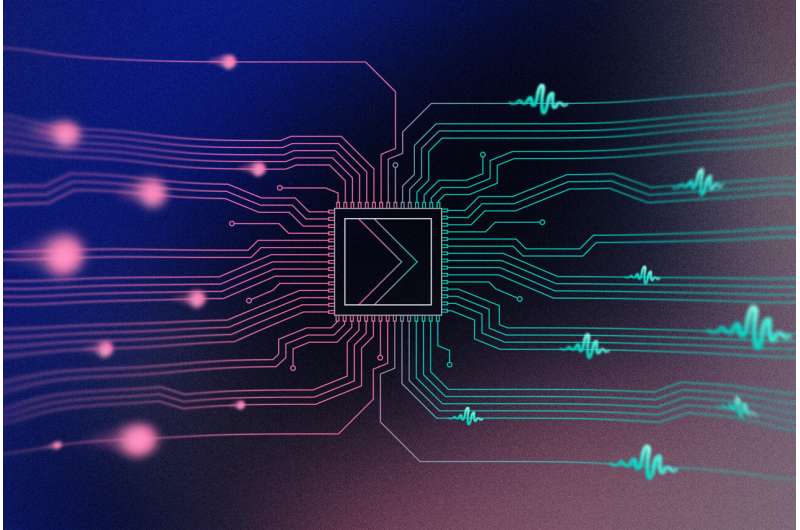This article has been reviewed according to Science X's editorial process and policies. Editors have highlighted the following attributes while ensuring the content's credibility:
fact-checked
peer-reviewed publication
trusted source
proofread
Quantum data conversion offers a path to scale up quantum technology architectures

Researchers at the Kastler Brossel Laboratory in Paris have succeeded in building the first converter between the two different types of quantum-bit encodings—an equivalent to converters for classical information, but targeted to different types of quantum data. This high-quality rewriting of information shows the way towards bridging the gap between the many different platforms competing in the race for quantum computing and may enable the interconnectivity of future networks.
In the February online issue of Nature Photonics, Prof. Julien Laurat and his colleagues at LKB (Sorbonne Université, CNRS, ENS-Université PSL, Collège de France) reported on the first successful demonstration of faithful qubit-encoding conversion. The quantum realm enables two different ways in which information can be stored and processed, discrete and continuous variables.
Similar to classical analog or digital information encodings, they are preferred for certain tasks and platforms. Researchers at LKB have found a way to translate one to another very distinct flavors of quantum information and thereby confirmed the possibility of interconnecting different quantum devices.
In the race for quantum computing, many platforms are now being developed, relying on different quantum systems, such as photons, neutral atoms, ions, superconductors, and semiconductors. For all these systems, several types of encoding exist, and the choice of it depends on the specific applications and available resources. Addressing this heterogeneity in quantum networks is a pressing issue. It would allow the integration of the best features of each for more robust and efficient networks.
Tackling heterogeneity early on in the development of quantum networks can prevent from compatibility issues and allows for seamless integration and interconnectivity of different quantum systems in the future. This task calls to the use of a quantum encoding converter, a device that preserves the fragile encoded quantum information signal while changing the basis upon which it is written.
Quantum bit conversion is a complex challenge. The straightforward way of creating a converter would be to measure information stored in one encoding and re-create this information into the other encoding. Unfortunately, quantum mechanics, and the so-called no-cloning theorem, does not allow this operation for arbitrary information.
In a way, this inconvenience is a blessing in disguise as the power of quantum cryptography is drawn from it. Nonetheless this forced the team at LKB to take another route in order to create a converter: using quantum entanglement.
Entanglement describes non-classical correlations between quantum systems. It was described by Einstein as a "spooky action at a distance." This spooky action, which sparked much confusion in the community at the beginning, is now the backbone of many proposals in the quantum research community. It is the protagonist of this year's 2022 Nobel Prize in Physics, and at the heart of the current quantum revolution.
"In fact, the second quantum revolution, also known as the era of quantum technologies, is driven by the ability to harness and control entanglement at the quantum level. The ability to create, manipulate and distribute entanglement opens the door to many new applications and technologies that cannot be achieved with classical systems alone," states Tom Darras, the first author of the study, now CEO and co-founder of the quantum startup Welinq.
The qubit converter implementation can be broken down into three main steps. Firstly, the key resource, entanglement, has to be created. Secondly, the input qubit is sent to the converter. Lastly, a special measurement, called "Bell-state measurement," must be performed, resulting in the teleportation of the input information to the output qubit. In this process, in strong contrast to other teleportation protocols, the qubit has been rewritten into another basis.
To create all resource states the Paris researchers used highly-efficient nonlinear optical sources, called optical parametric oscillators, that output high purity single photon or optical cat states upon a heralding event, dependent on the chosen crystal. They also relied on high-efficiency superconducting single-photons detectors.
To succeed, this process required a very specific kind of resource optical entanglement, a "hybrid-entangled state" between a so-called discrete-variable qubit and a continuous-variable Schrödinger cat qubit. In order to enable a Bell-state measurement the single-photon part of the hybrid entanglement is made to interfere with the input qubit, followed by a boosted single-photon detection. For verification, the output qubit is characterized with a process known as "quantum tomography" to calculate the fidelity between the input and output qubit, a typical method to assess the quality of the process. Conversion above the classical limit was confirmed for any input qubit.
"The success of this process is an important milestone for quantum technology infrastructures. Once we can interconnect quantum devices, more complex and efficient networks can be built." says Beate Asenbeck, a Ph.D. student at LKB and one of the leading authors of the paper. "It is amazing to think that with the technology of just ten years ago this task would have been nearly impossible. It's a very exciting time to see that advancing our fundamental understanding of the quantum realm is pushing our technological boundaries."
More information: Tom Darras et al, A quantum-bit encoding converter, Nature Photonics (2022). DOI: 10.1038/s41566-022-01117-5
Journal information: Nature Photonics
Provided by Sorbonne University





















